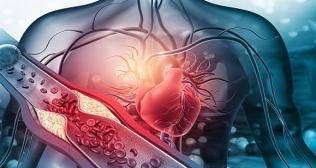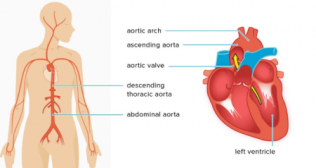
Cardiac Sciences
Heart Rhythm Disorders
Heart Rhythm Disorders Jun 26, 2015
There is hardly any person who has not felt palpitations or sinking sensation at one time or the other. Palpitation usually occurs due to increased frequency or increased force of heart beat or premature beats while sinking sensation occurs either due to low blood pressure or low heart rate or due to a gap after a premature beat. Increased frequency of heart beat also includes missed beats which are premature or irregular in addition to usual regular heart beat.
 Symptoms
Occasionally, palpitations occur in episodes with symptoms of sinking, sweating, giddiness or even near loss of consciousness. Such symptoms are more sinister and require a visit to the emergency room of a hospital. More often than not, palpitation or sensation of faster heart beat is benign. Palpitation can also occur due to use of drugs to control asthma or nasal drops. When palpitation occurs without these conditions, one needs to consult a physician. Spectrum of rhythm disorders extends from very inconsequential, to nuisance only and to lifethreatening. Clearly, a lay person is in no position to differentiate amongst them. The following are good enough reasons to consult a cardiologist:
• Palpitation followed by sudden loss of consciousness
• Sinking sensation with fall
• Sinking sensation followed by involuntary body movements and rolling of eyes
• Episodic palpitation lasting several minutes or hours
• Sustained palpitation with previously known heart condition
• Repeated episodes of sudden loss of consciousness
• Palpitation associated with chest pain, vomiting, sweating or loss of postural control
• Palpitation episodes which have been treated by some physician in the past by injection
• Use of anti-allergic or antidepression drugs as the initiator of palpitations
• Palpitation occurring in a person with sudden death of a family member
• Palpitation continuing for longtime after cessation of exercise
• Palpitation associated withshortness of breath or choking sensation
• When palpitation and sinking sensation alternate
• Prior pacemaker or device implant
• Prior thyroid disorders (on thyro- active drugs)
Work-up of such complaints starts with a good history, clinical examination followed by an ECG. Biochemical tests are required to discover thyroid disorders, diabetes mellitus, electrolyte imbalance,
etc. An echocardiographic examination may be performed to detect structural defect as the cause. A single resting ECG may not be sufficient especially when palpitation or sinking occur as infrequent episodes. In such cases, extended ECG monitoring either by Holter or external loop recorder can be performed. External loop recorders are wearble chips which constantly monitor ECG for 7-10 days.
Rarely, if one cannot find out the type of palpitation or cause of sinking and rhythm disorder is strongly suspected, implantable loop recorder can be used which can record ECG for one-three years and is implanted under the skin in a five-minute operation. In many cases where rhythm disorder is already documented or isconsidered a possibility, invasive electrophysiological studies may be required. These studies not only help in detecting the cause but also localise the focus. Thus, we can ablate or extinguish the focus with radiofrequency current and terminate the cause of palpitation due to episodic fast heart rate.
Symptoms
Occasionally, palpitations occur in episodes with symptoms of sinking, sweating, giddiness or even near loss of consciousness. Such symptoms are more sinister and require a visit to the emergency room of a hospital. More often than not, palpitation or sensation of faster heart beat is benign. Palpitation can also occur due to use of drugs to control asthma or nasal drops. When palpitation occurs without these conditions, one needs to consult a physician. Spectrum of rhythm disorders extends from very inconsequential, to nuisance only and to lifethreatening. Clearly, a lay person is in no position to differentiate amongst them. The following are good enough reasons to consult a cardiologist:
• Palpitation followed by sudden loss of consciousness
• Sinking sensation with fall
• Sinking sensation followed by involuntary body movements and rolling of eyes
• Episodic palpitation lasting several minutes or hours
• Sustained palpitation with previously known heart condition
• Repeated episodes of sudden loss of consciousness
• Palpitation associated with chest pain, vomiting, sweating or loss of postural control
• Palpitation episodes which have been treated by some physician in the past by injection
• Use of anti-allergic or antidepression drugs as the initiator of palpitations
• Palpitation occurring in a person with sudden death of a family member
• Palpitation continuing for longtime after cessation of exercise
• Palpitation associated withshortness of breath or choking sensation
• When palpitation and sinking sensation alternate
• Prior pacemaker or device implant
• Prior thyroid disorders (on thyro- active drugs)
Work-up of such complaints starts with a good history, clinical examination followed by an ECG. Biochemical tests are required to discover thyroid disorders, diabetes mellitus, electrolyte imbalance,
etc. An echocardiographic examination may be performed to detect structural defect as the cause. A single resting ECG may not be sufficient especially when palpitation or sinking occur as infrequent episodes. In such cases, extended ECG monitoring either by Holter or external loop recorder can be performed. External loop recorders are wearble chips which constantly monitor ECG for 7-10 days.
Rarely, if one cannot find out the type of palpitation or cause of sinking and rhythm disorder is strongly suspected, implantable loop recorder can be used which can record ECG for one-three years and is implanted under the skin in a five-minute operation. In many cases where rhythm disorder is already documented or isconsidered a possibility, invasive electrophysiological studies may be required. These studies not only help in detecting the cause but also localise the focus. Thus, we can ablate or extinguish the focus with radiofrequency current and terminate the cause of palpitation due to episodic fast heart rate.
 Symptoms
Occasionally, palpitations occur in episodes with symptoms of sinking, sweating, giddiness or even near loss of consciousness. Such symptoms are more sinister and require a visit to the emergency room of a hospital. More often than not, palpitation or sensation of faster heart beat is benign. Palpitation can also occur due to use of drugs to control asthma or nasal drops. When palpitation occurs without these conditions, one needs to consult a physician. Spectrum of rhythm disorders extends from very inconsequential, to nuisance only and to lifethreatening. Clearly, a lay person is in no position to differentiate amongst them. The following are good enough reasons to consult a cardiologist:
• Palpitation followed by sudden loss of consciousness
• Sinking sensation with fall
• Sinking sensation followed by involuntary body movements and rolling of eyes
• Episodic palpitation lasting several minutes or hours
• Sustained palpitation with previously known heart condition
• Repeated episodes of sudden loss of consciousness
• Palpitation associated with chest pain, vomiting, sweating or loss of postural control
• Palpitation episodes which have been treated by some physician in the past by injection
• Use of anti-allergic or antidepression drugs as the initiator of palpitations
• Palpitation occurring in a person with sudden death of a family member
• Palpitation continuing for longtime after cessation of exercise
• Palpitation associated withshortness of breath or choking sensation
• When palpitation and sinking sensation alternate
• Prior pacemaker or device implant
• Prior thyroid disorders (on thyro- active drugs)
Work-up of such complaints starts with a good history, clinical examination followed by an ECG. Biochemical tests are required to discover thyroid disorders, diabetes mellitus, electrolyte imbalance,
etc. An echocardiographic examination may be performed to detect structural defect as the cause. A single resting ECG may not be sufficient especially when palpitation or sinking occur as infrequent episodes. In such cases, extended ECG monitoring either by Holter or external loop recorder can be performed. External loop recorders are wearble chips which constantly monitor ECG for 7-10 days.
Rarely, if one cannot find out the type of palpitation or cause of sinking and rhythm disorder is strongly suspected, implantable loop recorder can be used which can record ECG for one-three years and is implanted under the skin in a five-minute operation. In many cases where rhythm disorder is already documented or isconsidered a possibility, invasive electrophysiological studies may be required. These studies not only help in detecting the cause but also localise the focus. Thus, we can ablate or extinguish the focus with radiofrequency current and terminate the cause of palpitation due to episodic fast heart rate.
Symptoms
Occasionally, palpitations occur in episodes with symptoms of sinking, sweating, giddiness or even near loss of consciousness. Such symptoms are more sinister and require a visit to the emergency room of a hospital. More often than not, palpitation or sensation of faster heart beat is benign. Palpitation can also occur due to use of drugs to control asthma or nasal drops. When palpitation occurs without these conditions, one needs to consult a physician. Spectrum of rhythm disorders extends from very inconsequential, to nuisance only and to lifethreatening. Clearly, a lay person is in no position to differentiate amongst them. The following are good enough reasons to consult a cardiologist:
• Palpitation followed by sudden loss of consciousness
• Sinking sensation with fall
• Sinking sensation followed by involuntary body movements and rolling of eyes
• Episodic palpitation lasting several minutes or hours
• Sustained palpitation with previously known heart condition
• Repeated episodes of sudden loss of consciousness
• Palpitation associated with chest pain, vomiting, sweating or loss of postural control
• Palpitation episodes which have been treated by some physician in the past by injection
• Use of anti-allergic or antidepression drugs as the initiator of palpitations
• Palpitation occurring in a person with sudden death of a family member
• Palpitation continuing for longtime after cessation of exercise
• Palpitation associated withshortness of breath or choking sensation
• When palpitation and sinking sensation alternate
• Prior pacemaker or device implant
• Prior thyroid disorders (on thyro- active drugs)
Work-up of such complaints starts with a good history, clinical examination followed by an ECG. Biochemical tests are required to discover thyroid disorders, diabetes mellitus, electrolyte imbalance,
etc. An echocardiographic examination may be performed to detect structural defect as the cause. A single resting ECG may not be sufficient especially when palpitation or sinking occur as infrequent episodes. In such cases, extended ECG monitoring either by Holter or external loop recorder can be performed. External loop recorders are wearble chips which constantly monitor ECG for 7-10 days.
Rarely, if one cannot find out the type of palpitation or cause of sinking and rhythm disorder is strongly suspected, implantable loop recorder can be used which can record ECG for one-three years and is implanted under the skin in a five-minute operation. In many cases where rhythm disorder is already documented or isconsidered a possibility, invasive electrophysiological studies may be required. These studies not only help in detecting the cause but also localise the focus. Thus, we can ablate or extinguish the focus with radiofrequency current and terminate the cause of palpitation due to episodic fast heart rate.



















